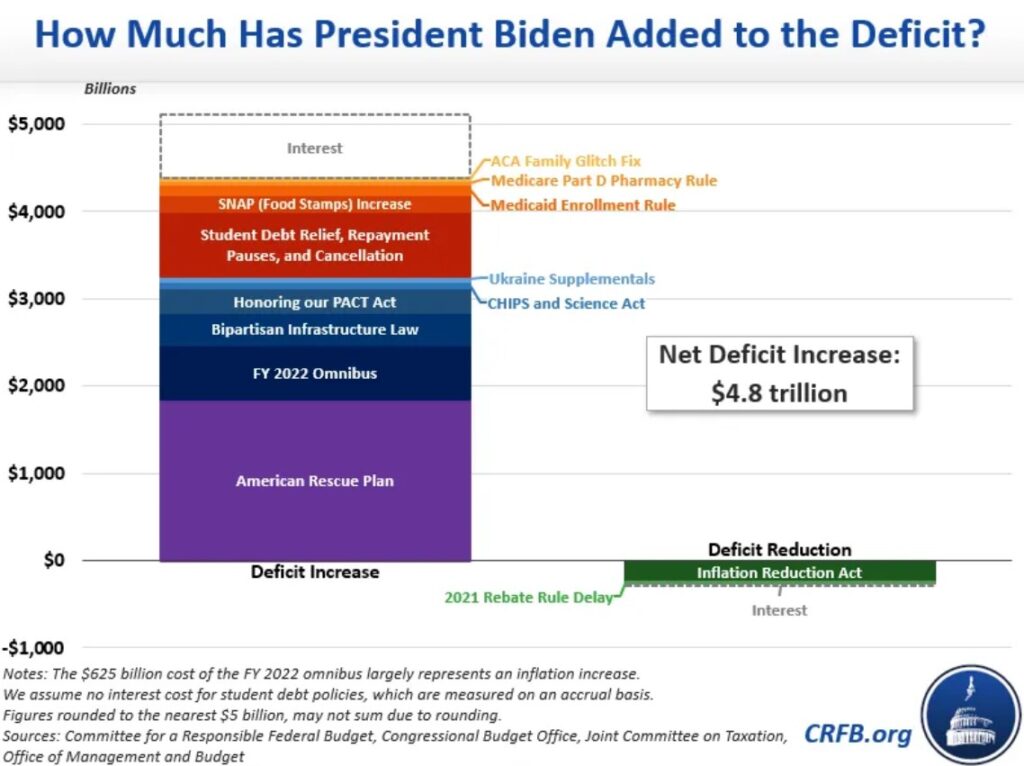Budget Analysts Conclude Biden Policies Will Add $4.8 Trillion to National Debt
Why does inflation continue to plague American households? Part of the problem stems from monetary policies the Federal Reserve put into place as a stimulus response to Covid-19 and kept in place for far too long. But a new analysis puts much of the blame — $4,800,000,000,000 worth, to be exact — at the feet of President Biden.
The estimate by the Committee for a Responsible Federal Budget (CRFB) in some ways understates the scope of the fiscal irresponsibility by this administration — in far too many cases with at least some Republican support. But it speaks to the extent of the reforms that future administrations, and frankly future generations, will have to enact to clean up the fiscal mess that Biden and current lawmakers have created.

Spending Like Drunken Sailors
One can characterize the policies included in the CRFB analysis into three broad buckets.
Administrative Actions: These consist of executive policies enacted without approval from Congress (and, at least some would argue, without authority from Congress).
- Student “loan forgiveness,” which according to CRFB will cost $750 billion.
- A more than 20 percent increase in the reference cost of food stamps, which will cost $185 billion.
- A series of health-related administrative actions, including a (questionably legal) proposal to alter the Obamacare subsidy regime, and a recent proposal designed to liberalize the Medicaid enrollment process. In total, CRFB concludes these actions will cost $175 billion.
Bipartisan Legislation: Many other budget-busting measures passed with significant bipartisan support — in this case, at least 10 Republican votes to overcome a filibuster in the Senate. These bills include:
- The omnibus spending legislation enacted this March, which the CRFB analysis notes will increase discretionary spending by $625 billion over a decade, assuming the higher spending levels in the measure continue to rise with inflation.
- The infrastructure measure enacted last summer, which included several notable budget gimmicks and according to CRFB will result in $370 billion of debt.
- Legislation regarding veterans’ benefits (i.e., the “burn pit bill”) passed by Congress this summer, which will result in $280 billion in additional deficits and debt.
- The semiconductor legislation passed over the summer, which contained $80 billion in new automatic spending for various subsidized corporate projects.
- A total of $55 billion in supplemental spending since Russia invaded Ukraine earlier this year.
These measures account for more than $1.4 trillion in new deficits and debt, even before one considers interest costs. Even if some of the projects included in the bills have merit, responsible lawmakers would have demanded spending reductions elsewhere in the budget to offset these new outlays.
Partisan Legislation: This bucket includes the two measures Democrats rammed through along party lines via the budget reconciliation process, which allowed Senate Democrats to avoid a Republican filibuster. According to CRFB, the “Covid relief” measure Democrats enacted last year will add $1.85 trillion to the debt, while the “Inflation Reduction Act” signed last month will reduce the debt by $240 billion.
In addition to all the added spending above, CRFB calculates an additional $700 billion in estimated higher interest rate costs over the coming decade to arrive at its $4.8 trillion figure.
Analysis Too Optimistic?
Believe it or not, some would argue that the CRFB analysis doesn’t go far enough when quantifying the effects of this administration’s fiscal irresponsibility. For instance, the Penn-Wharton budget model concluded that the cost of the Biden “loan forgiveness” program “could exceed $1 trillion,” several hundred billion dollars more than the CRFB estimate.
The CRFB analysis also takes the $240 billion of supposed deficit reduction from the “Inflation Reduction Act” at face value, rather than looking behind some of the budget gimmicks and questionable assumptions in that law.
It says something about the Democrats’ agenda that nearly $5 trillion represents a conservative estimate of the amount that this administration’s actions have added to the national debt. Republicans, who have no great history of cutting spending — either in this administration or during the last one — had better get ready to make some tough choices in the years ahead. Whether they want to or not, our country’s dire fiscal situation will almost certainly require it.
This post was originally published at The Federalist.